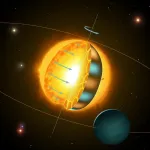The science of spin -- asteroseismologists confirm older stars rotate faster than expected
2021-04-22
(Press-News.org) Stars spin faster than expected as they age according to a new study led by scientists at the University of Birmingham which uses asteroseismology to shed new light on this emerging theory.
All stars, like the Sun, are born spinning. As they grow older, their spin slows down due to magnetic winds in a process called 'magnetic braking'. Research published in 2016 by scientists at Carnegie Observatories delivered the first hints that stars at a similar stage of life as the Sun were spinning faster than magnetic braking theories predicted. The results from this study were based on a method in which scientists pinpoint dark spots on the surface of stars and track them as they move with the stars' spin. While the method has proven robust for measuring spin in younger stars, however, older stars have fewer star spots, which has made the effects of this "weakened" magnetic braking on these stars hard to confirm.
In a new study, published in Nature Astronomy, researchers at the University of Birmingham used a different approach to confirm that older stars do, in fact, appear to rotate faster than expected. The team used asteroseismology to calculate how the star is rotating. This relatively new field of study enables scientists to measure the oscillations caused by sound waves trapped inside the star. By measuring the different characteristics of these waves, they can reveal different characteristics of stars, such as their size or age.
In this study, the team measured the modes, or the frequencies, of the sound waves produced by the star's oscillation. As the star spins, these modes split into different frequencies. This can be imagined, the author's say, as the sound of two ambulances stood still on a roundabout compared to when they are driving in circles. By measuring these frequencies, it is possible to calculate the rate of spin in a way that is possible for both young and old stars.
Lead author on the paper, Dr Oliver Hall, said: "Although we've suspected for some time that older stars rotate faster than magnetic braking theories predict, these new asteroseismic data are the most convincing yet to demonstrate that this 'weakened magnetic braking' is actually the case. Models based on young stars suggest that the change in a star's spin is consistent throughout their lifetime, which is different to what we see in these new data."
One aspect the researchers believe could be key to the change in momentum loss, is changes to the star's magnetic field. Understanding how the magnetic field interacts with rotation will be an important area of future study, and is being worked on by authors on the paper.
The results could also shed light on our own star's activity over the next several billion years, explains co-author Dr Guy Davies: "These new findings demonstrate that we still have a lot to learn about the future of our own Sun as well as other stars. This work helps place in perspective whether or not we can expect reduced solar activity and harmful space weather in the future. To answer these questions we need better models of solar rotation, and this work takes an important step towards improving the models and supplying the data needed to test them."
INFORMATION:
Other contributors to the study include the European Space Agency (ESA), Aarhus University, University of Hawai'i, Universit´e Paris-Saclay, and the University of Exeter.
[Attachments] See images for this press release:

ELSE PRESS RELEASES FROM THIS DATE:
2021-04-22
What The Study Did: This case series reports the risk factors, incidence rate and features of acute ischemic stroke experienced by a group of male patients ages 50 years or younger in the convalescent stage of COVID-19.
Authors: Tian Ming Tu, M.R.C.P., of the National Neuroscience Institute in Singapore, is the corresponding author.
To access the embargoed study: Visit our For The Media website at this link https://media.jamanetwork.com/
(doi:10.1001/jamanetworkopen.2021.7498)
Editor's Note: The article includes conflict of interest disclosures. Please see the article for additional information, including other authors, ...
2021-04-22
What The Study Did: This study assesses the association between COVID-19 and maternal and neonatal outcomes in pregnant women with COVID-19 diagnosis compared with pregnant women without COVID-19 diagnosis.
Authors: Aris T.Papageorghiou, M.D., of the University of Oxford in the United Kingdom, is the corresponding author.
To access the embargoed study: Visit our For The Media website at this link https://media.jamanetwork.com/
(doi:10.1001/jamapediatrics.2021.1050)
Editor's Note: The article includes conflict of interest and funding/support disclosures. Please see the article for additional information, including ...
2021-04-22
What The Study Did: This cohort study examines viral dynamics and transmission of infection for NBA players, staff and vendors who had clinically recovered from SARS-CoV-2 infection but continued to have positive test results following discontinuation of isolation precautions.
Authors: Christina Mack, Ph.D., M.S.P.H., of IQVIA, Real World Solutions, in Durham, North Carolina, is the corresponding author.
To access the embargoed study: Visit our For The Media website at this link https://media.jamanetwork.com/
(doi:10.1001/jamainternmed.2021.2114)
Editor's ...
2021-04-22
What The Study Did: This review of 125 U.S.-based clinical trials that investigated the management of hearing loss assessed representation in the trials by race/ethnicity and sex.
Authors: Carrie Nieman M.D., M.P.H., of the Johns Hopkins University Bloomberg School of Public Health in Baltimore, is the corresponding author.
To access the embargoed study: Visit our For The Media website at this link https://media.jamanetwork.com/
(doi:10.1001/jamaoto.2021.0550)
Editor's Note: The article includes conflicts of interest and funding/support disclosures. Please see the article for additional ...
2021-04-22
What The Study Did: Claims data were used to look at opioid use among young people (ages 10 to 21) who had been prescribed opioids for the first time.
Authors: J. Deanna Wilson, M.D., M.P.H., of the University of Pittsburgh School of Medicine, is the corresponding author.
To access the embargoed study: Visit our For The Media website at this link https://media.jamanetwork.com/
(doi:10.1001/jamanetworkopen.2021.4552)
Editor's Note: The article includes conflicts of interest and funding/support disclosures. Please see the article for additional information, including other authors, author contributions and affiliations, conflict of interest and financial disclosures, and funding and support.
# ...
2021-04-22
What The Study Did: Researchers investigated racial/ethnic representation in clinical trials that led to U.S. Food and Drug Administration approval of ophthalmology drugs from 2000 to 2020.
Authors: Shriji Patel, M.D., of Vanderbilt University Medical Center in Nashville, Tennessee, is the corresponding author.
To access the embargoed study: Visit our For The Media website at this link https://media.jamanetwork.com/
(doi:10.1001/jamaophthalmol.2021.0857)
Editor's Note: The article includes conflicts of interest and funding/support disclosures. Please see the article for additional information, including other authors, author contributions and affiliations, conflict of interest and financial disclosures, and funding and support.
# # ...
2021-04-22
BOSTON -- The foods people buy at a workplace cafeteria may not always be chosen to satisfy an individual craving or taste for a particular food. When co-workers are eating together, individuals are more likely to select foods that are as healthy--or unhealthy--as the food selections on their fellow employees' trays. "We found that individuals tend to mirror the food choices of others in their social circles, which may explain one way obesity spreads through social networks," says Douglas Levy, PhD, an investigator at the Mongan Institute Health Policy Research Center at Massachusetts General Hospital (MGH) ...
2021-04-22
A phase 1 clinical trial led by investigators at the University of Chicago Medicine testing the effects of stereotactic body radiotherapy for treating multiple metastases has determined that treatments used for single tumors can also be safely used for treating patients with multiple metastases. The study was run through NRG Oncology and sponsored by the National Cancer Institute. The results were published on April 22 in JAMA Oncology.
Cancer is traditionally treated with a combined approach, with clinicians using surgery, chemotherapy and radiation therapy to kill and remove cancerous tumors. Systemic ...
2021-04-22
PHILADELPHIA--When researchers from Penn Medicine found that many patients with B-cell acute lymphoblastic leukemia (ALL) treated with the investigational chimeric antigen receptor (CAR) T cell therapy targeting the CD22 antigen didn't respond, they went back to the drawing board to determine why. They discovered that less is more when it comes to the length of what is known as the single-chain variable fragment -- the linker that bridges the two halves of the receptor that allows CAR T cells to latch onto tumor cells and attack them.
The findings are reported online today in Nature Medicine.
"A little difference of a few amino acids can make a huge difference for patients," said co-senior author Marco Ruella, MD, an ...
2021-04-22
The 'stickiness', or viscosity, of microscopic liquids can now be measured thousands of times faster than ever before, potentially leading to better understanding of living cells, disease diagnostics and pharmaceutical testing.
University of Queensland's Professor Warwick Bowen and his colleagues at the Queensland Quantum Optics Lab developed the world-leading technology, technology that uses lasers to track microscale particles with world-record precision.
"The stickiness, or viscosity, of liquids is incredibly important in biology," Professor Bowen said.
"In living cells, viscosity fluctuations control shape and structure, modulate chemical reactions, and signal whether a cell is healthy or cancerous.
"However, ...
LAST 30 PRESS RELEASES:
[Press-News.org] The science of spin -- asteroseismologists confirm older stars rotate faster than expected

